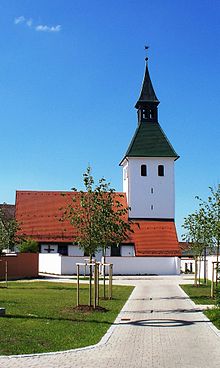Seuversholz
|
Seuversholz
Municipality Pollenfeld
Coordinates: 48 ° 57 ′ 5 ″ N , 11 ° 11 ′ 1 ″ E
|
|
|---|---|
| Height : | 545 (536-545) m |
| Residents : | 404 (Jan. 1, 2015) |
| Incorporation : | January 1, 1972 |
| Postal code : | 85131 |
| Area code : | 08421 |
Seuversholz , together with the north-western desert brickworks, is part of the municipality of Pollenfeld in the Upper Bavarian district of Eichstätt .
location
The place is located on the plateau of the southern Franconian Alb north of the Altmühltal . State roads 2047 and 2228 run through the village .
history
"Sigewnesholz" (probably after the person's name Sigewin) 1080 at the Wildbann donation mentioned in a document by King Henry IV. To the Bishop of Eichstatt Udalrich first time. Around 1150, Pillunk von “Sivenholz” is a local aristocrat as a witness in a document from the Augustinian Canons - Berchtesgaden Abbey . In 1239, ownership of the Augustinian Canons' Abbey in Rebdorf in "Sidensholz" can be proven. In the dispute over the Hirschberg legacy after the extinction of the Counts of Hirschberg with Count Gebhard VII, the Seuversholz village court was awarded to the empire in 1306. In 1465, the Eichstatt Bishop Seuversholz received the bailiwick and court as an imperial fief from Stephan Schenk von Geyern; In 1484 the Eichstätter cathedral chapter handed over its goods to "Seibersholz" to Bishop Wilhelm von Reichenau , who in 1486 also came into the possession of the Rebdorf goods from Seuversholz through an exchange. The episcopal property was subordinate to the court box office of the Middle Hochstift Eichstätt until secularization . The Eichstätter Willibaldschorstift, the Eichstätter Siechhof and the Eichstätter Stadtkastenamt also owned Seuversholz. An episcopal forester sat in the village. Together with six other places, Seuversholz formed one of the three prisoners in the office of the Landvogtei Eichstätt.
The Office of the High pin Eichstätt fell Reichsdeputationshauptschluss 1803 with most of the hochstiftischen area, including Seuversholz, to the Principality of Eichstätt of Archduke Ferdinand of Tuscany . Since the peace treaties of Brno and Preßburg of 1805, the place belonged to the royal Bavarian district court Eichstätt and in 1808 formed the tax district Seuversholz together with the nearby brickworks of the former court box office, with Weigersdorf and with the former ducal Gestüt Geländer (today an inn with wild boar enclosure) . During the Leuchtenberg period, in 1819 Seuversholz with its 50 houses, in which 251 people lived, and Weigersdorf, with its 17 houses and 104 residents, were formed into a political municipality; In 1824 the two places regained their independence. In 1870 a new schoolhouse was built.
In 1902, a savings and loan association Seuversholz was founded (since 1977 Raiffeisenbank Seuversholz-Eichstätt eG), which built a warehouse. From 1949 to 1955 land consolidation was carried out with land swap with pollen field. On January 1, 1972, Seuversholz was incorporated into the municipality of Pollenfeld. Since the district reform , which came into force on July 1, 1972, Pollenfeld has belonged to the Upper Bavarian district of Eichstätt in its new, significantly enlarged form. In 1981 Seuversholz celebrated its 900th anniversary. In 1983 Seuversholz had a population of 383, including twelve full-time farms and 30 part-time businesses.
Catholic branch church St. Nikolaus
The branch church of Pollenfeld was rebuilt in 1564 and expanded in 1698. The tower with its helmet with a four-sided lantern is typical of the Eichstätter court architect Jakob Engel . In 1698 the church got a new high altar, while the old high altar was used as a side altar. In 1882, when the nave was lengthened, the pulpit, a work by the plasterer Franz Xaver Horneis from 1743, was removed and a second side altar was erected. Between 1863 and 1867 the three altars were renewed. In 1968 the church was expanded again, and in 1974 the nave was rebuilt. A sacrament niche dates from the early 15th century, the rest of the furnishings are late Gothic and Baroque . The Nazarene- style image of the church patron on the main altar from the mid-19th century was renovated in 2008.
Others
- War memorial, rebuilt in 1997.
- Steinmarterl from 1588 on the road from Seuversholz to Pollenfeld, restored in 2009.
- Chapel at the Ziegelhütte, built in 1956.
- Field cross at the brickworks, erected in 1877.
- St. Mary's Chapel, built in 1848.
societies
- Volunteer Fire Brigade (founded in 1879)
- Garden and landscape maintenance association
- Bergschlag-Böllerschützen (founded in 1988)
- Seuversholzer Hütt'n
- Catholic boys association
- Hunting association
Personalities
- Georg Sailer, General and Imperial Councilor, * 1675 as the son of a landlord in Seuversholz, † in Vienna
Individual evidence
- ↑ Data on the municipality. Community of Pollenfeld, accessed on June 16, 2017 .
- ^ Wilhelm Volkert (ed.): Handbook of Bavarian offices, communities and courts 1799–1980 . CH Beck'sche Verlagsbuchhandlung, Munich 1983, ISBN 3-406-09669-7 , p. 456 .
literature
- Felix Mader (arr.): The art monuments of Middle Franconia. II. Eichstätt District Office. Munich 1928. (Reprint 1982, p. 328f)
- Historical Atlas of Bavaria. Franken series I issue 6: Eichstätt . 1959.
- Collective sheet of the historical association Eichstätt. 61 (1965/66), p. 38.
- 100 years of the Seuversholz volunteer fire brigade with flag consecration (900 years of Seuversholz) from July 18 to 20, 1980 . Seuversholz 1980.
- The Eichstätter area past and present. Eichstätt 1973, p. 285. (2nd expanded edition. 1984, p. 284)
- Bert Braun: Large community of Pollenfeld with the community parts. Erlangen-Spardorf 1984, especially p. 512ff.
